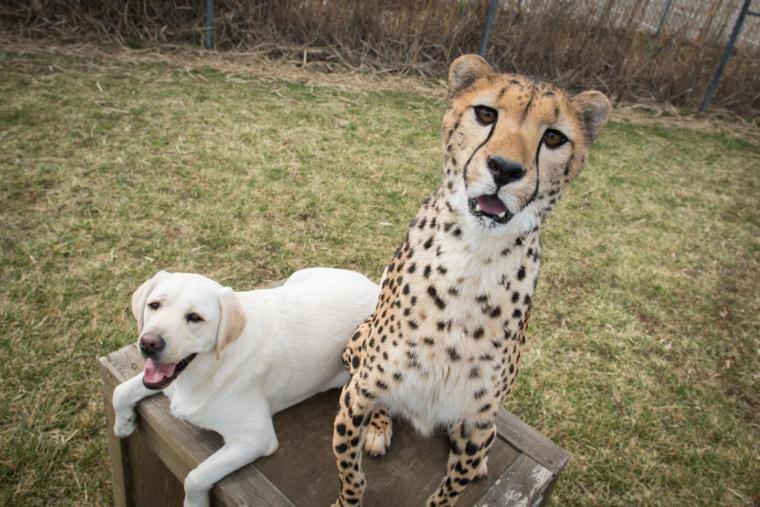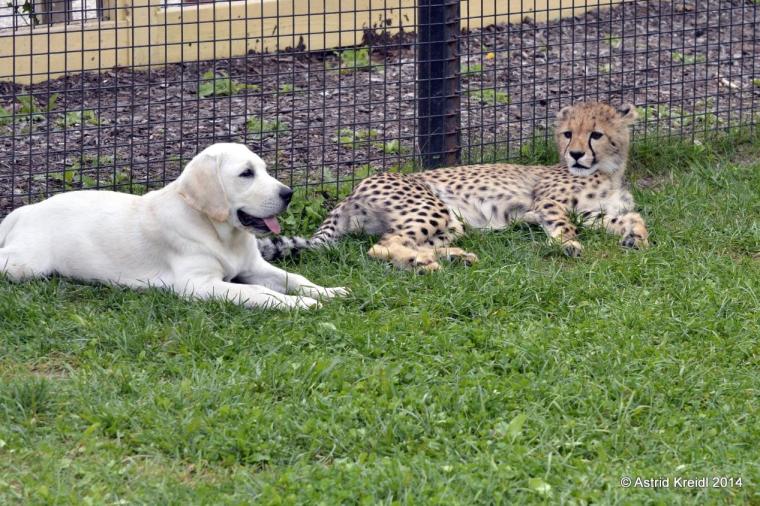Tale by Tail set out to explore the fascinating relationship between cheetahs and dogs, and talked to zoos to find out how this unlikely duo is improving the lives of both species at their respective establishments. Each week, a different zoo will be featured on the blog and the various cheetah/dog bonds at each park will be highlighted. This week, Tale by Tail will be sharing the story of the cheetahs and dogs at the Columbus Zoo and Aquarium in Ohio, a zoo known for these special cat and dog friendships.
Although dogs have always been man’s best friend, one species is proving that confident canines are loved by more than just humans.
At the Columbus Zoo and Aquarium, dogs have been giving reassurance to the fastest land animal in the kingdom: the cheetah. Cheetahs may be large and they may be quick, but they are also fearful, and confident dogs give them just what they need to thrive in the zoo environment.

For years the Ohio zoo has been using dogs as companions for their spotted cats, Animal Programs Director Suzi Rapp told Tale by Tail. Currently, the zoo has yellow labs and Anatolian shepherds to work with the zoo’s 14 cheetahs, and one of those cheetahs is Emmett, a cub that will be getting his own puppy any day now — the puppy has to be 6 weeks old before it is ready to mingle.
“Emmet’s puppy will only probably be good with Emmett, but once I get more cheetahs, his puppy will be acclimated to new cheetahs,” Rapp said, and that is because dogs can be paired with cheetahs at any point, but cheetahs can only be paired with dogs when they are young.
Emmett, on the other hand, will be able to have a relationship with all of the dogs.
Although some may not expect these two different species to get along, dogs gives cheetahs something that humans cannot provide: the confidence they need to thrive.
“A cheetah is very fearful by nature; they’d rather flee than fight. We want all of our cheetahs to have all the confidence in the world,” Rapp said.
The best way to give them that confidence is to introduce them to a puppy at a young age; they end up thinking the dog is their sibling and do not realize they are any different. Yellow labs especially are very confident, so pairing a lab with a skittish cheetah is a good match, Rapp said.
“That dog is that cheetah’s confidence; if the cheetah looks at the dog and the dog is OK, then they are OK,” Rapp said. “We just want our cheetahs to have confidence and companionship and that’s the best way to do it. It’s reassurance that everything is OK.”
The zoo originally started getting Anatolian shepherds — Turkish guard dogs that Rapp said are bred to be “bad, big and loud” — as their companion animals, but once the staff realized that the shepherds were too protective of them and their vehicles while they were traveling, they looked at other options.
“They weren’t the best animals to take out,” Rapp said. “I decided I needed to go down a different route, so I thought what is the happiest, sweetest dog in the world? And we thought yellow lab.”
A couple of her yellow labs have proven that thought to be true, especially Coby, a dog that Rapp said every cheetah loves.
“He’s the chosen dog. As far as Coby goes, all of the animals love him, not just cheetahs,” Rapp said. “I can’t put my finger on it, he just has this aura or whatever it is.”
Recently, Rapp took Coby with her down to the Wilds — the part of the park where species roam freely — because the staff wanted to desensitize some of the animals in the pastures in case a guest was visiting the park with a service dog. When Rapp and Coby arrived, the giraffes flocked to the truck, including one that never approaches trucks, and started taking food from Rapp and the lovable dog.
“I said [to the Wilds staff] ‘Don’t expect that kind of welcome all the time because I will tell you, Coby is very special,'” Rapp said. “Even the cheetahs think that about him.”
Another dog that the cheetahs gravitate towards is Cash, a 2-year-old yellow lab. Although the younger cheetahs love the “big, white, chunky dog” and are very close to him, Rapp said Cash is not always the best choice to get work done.
“The downside is [the cheetahs and Cash are] just too goofy together. Cash hasn’t matured yet, he’s just now starting to come out of his puppy stage,” Rapp said. “When you have serious business to do, you don’t take Cash.”

Although Cash may not be the best at acting serious, he sure knows how to act compassionate. Both he and Coby comforted a cheetah cub named Kiara all hours of the day when she had to undergo surgery for a crushed growth plate. The young cheetah was born at another facility and was brought in by Rapp and the Columbus Zoo team when Kiara’s mother — a first-time cheetah mom — killed one of her cubs. Two females were saved, with Kiara being one of them. She was placed with other cheetahs at the zoo but when it was time for her surgery, she had to be removed from the group.
“She wasn’t used to being alone so Coby and Cash took turns laying with her. When Kiara was recovering she had her head on Coby,” Rapp said. “[About a month ago] was her first day out in the exhibit. Instead of putting her out there with the cheetahs, we put her out there with the dogs first and she did great. The dogs are gold for us.”
Lucky for the zoo, there is an “incredible” breeder right down the road where they get their yellow labs. Although the breeder was at first hesitant to sell her dogs to a zoo, she now loves that her dogs live there, Rapp said. The cheetahs, on the other hand, come from all over through the Association of Zoos and Aquariums’ (AZA) Species Survival Plan Program, a program that oversees the population management of select species.
Cheetah cubs also usually have to be hand raised, Rapp said, because the mother cheetah may get sick or be unable to care for her young for other reasons. Oftentimes organizations will call Rapp because they don’t have the manpower to hand raise the cubs themselves.
“Cheetahs are not the easiest to hand raise,” she said. “They require a lot of care and have a lot of issues, probably because genetically their pool is so small.”
That is the case with current cub Emmett, who Rapp said consumes the majority of her time. She does have help from her “incredible group of people” as well, she said, but she tries not to switch too often because cheetahs get used to their caretakers.
Although cheetahs get used to their human caretakers, and are “very doglike,” Rapp said people must remember that they are not dogs and they are often fearful of people.
“They’re wild animals. They look at strangers like ‘Who are you?’ They stalk little children because little children look like gazelles to them,” Rapp said. “You have to remember they’re wild animals, not dogs.”
Humans are not encouraged to approach cheetahs, unless of course they observe them in a controlled environment, like the zoo’s Heart of Africa exhibit. Each day, the zoo does three cheetah runs, running two cheetahs one at a time, as well as a dog with each cheetah for zoo goers to see.
When the cheetahs and dogs are not impressing zoo goers, they are playing nonstop. They play with toys, run and chase each other, and of course have their downtime too.
“They tumble and rough house when they’re young. They curl up and sleep together, and there are times when they’re like, ‘Get away from me, I don’t want you to sleep on me,'” Rapp said. “We also want them to realize they have to have separation too. We don’t want to make them too dependent on each other.”
When the dogs and cheetahs are not together, at night time for instance, the dogs will go home with staff members while the cheetahs relax at the zoo. Still, together or apart, the cheetahs and dogs at the Columbus Zoo have formed bonds that not only make zoo goers’ hearts melt, but also improve the lives of both species, and they can look forward to growing these friendships for the rest of their lives at the zoo.
“The dogs have very rich lives,” Rapp said. “And it’s such a great thing to do for a cheetah.”
To make a donation to the Cheetah Conservation Fund in Namibia, an organization The Columbus Zoo supports, click here.
